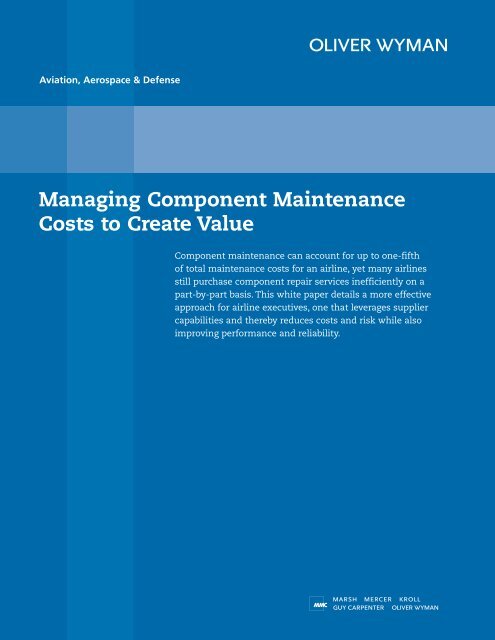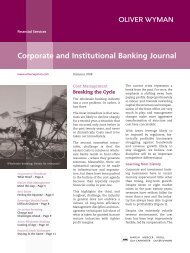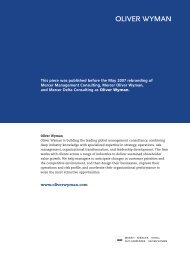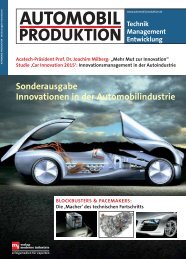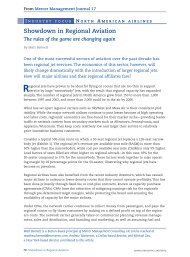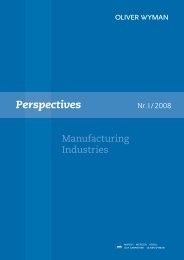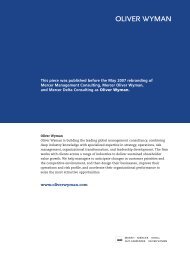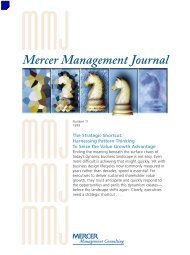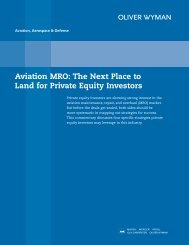Managing Component Maintenance Costs to Create ... - Oliver Wyman
Managing Component Maintenance Costs to Create ... - Oliver Wyman
Managing Component Maintenance Costs to Create ... - Oliver Wyman
You also want an ePaper? Increase the reach of your titles
YUMPU automatically turns print PDFs into web optimized ePapers that Google loves.
Aviation, Aerospace & Defense<br />
<strong>Managing</strong> <strong>Component</strong> <strong>Maintenance</strong><br />
<strong>Costs</strong> <strong>to</strong> <strong>Create</strong> Value<br />
<strong>Component</strong> maintenance can account for up <strong>to</strong> one-fifth<br />
of <strong>to</strong>tal maintenance costs for an airline, yet many airlines<br />
still purchase component repair services inefficiently on a<br />
part-by-part basis. This white paper details a more effective<br />
approach for airline executives, one that leverages supplier<br />
capabilities and thereby reduces costs and risk while also<br />
improving performance and reliability.
For many airlines line replaceable unit (LRU) component<br />
maintenance, repair, and overhaul (MRO) represents<br />
a complex management challenge. For a variety<br />
of reasons, including expiring warranty coverage,<br />
aircraft aging, OEM-generated service bulletins, parts<br />
availability, and the sheer volume of parts <strong>to</strong> manage,<br />
airlines often experience escalating <strong>to</strong>tal costs. Yet<br />
many airlines are missing opportunities <strong>to</strong> control<br />
component maintenance costs, which typically<br />
range between 15 and 20% of their <strong>to</strong>tal MRO cost.<br />
Our experience suggests several proven tactics that<br />
can be employed <strong>to</strong> manage component maintenance<br />
cost drivers. Indeed, by leveraging supplier<br />
capabilities, airlines can significantly reduce maintenance<br />
expenses, improve predictability, reduce<br />
maintenance risk, and at the same time increase<br />
part availability and overall reliability levels.<br />
To realize those benefits, airline executives must<br />
build partnerships that align the airline’s risk with<br />
that of the MRO providers. These partnerships<br />
should be built around five principles:<br />
• Develop detailed, probabilistic models on maintenance<br />
costs over the lifecycle of the aircraft<br />
from the belief that having a long-term LRU component<br />
maintenance agreement will mean missing<br />
out on future MRO cost reductions. Some of the cost<br />
uncertainties relate <strong>to</strong> environmental fac<strong>to</strong>rs, usage<br />
patterns, interchangeability between parts, no fault<br />
founds, and modifications that can affect the reliability<br />
of LRU components.<br />
However, part-by-part strategies typically do not<br />
maximize value over the lifecycle of the aircraft. A<br />
more effective sourcing approach focuses on developing<br />
a long-term perspective on maintenance costs,<br />
particularly on <strong>to</strong>tal-cost-of-ownership elements<br />
such as inven<strong>to</strong>ry ownership and parts availability.<br />
This approach is anchored by a robust, baseline<br />
spend-analysis model, which provides a detailed,<br />
systematic perspective on current maintenance<br />
costs and a probabilistic perspective on future<br />
maintenance requirements. By understanding the<br />
key drivers of spend and having a model that can<br />
simulate future spend over the entire fleet, maintenance<br />
executives can project a maintenance cost<br />
curve for the next five <strong>to</strong> ten years. Insight gained<br />
from the model can inform dialogues between<br />
maintenance executives and their MRO supplier<br />
counterparts.<br />
• Leverage market options<br />
• Align risk<br />
• Clarify the gray areas<br />
• Rigorously manage the sourcing process<br />
Develop a Detailed Perspective on<br />
<strong>Maintenance</strong>-Lifecycle <strong>Costs</strong><br />
Many airlines purchase component repair services<br />
on a discrete, part-by-part basis, whether in the<br />
spot market or under longer-term agreements.<br />
Pricing structures typically range from simple time<br />
and materials <strong>to</strong> fixed prices per usage increment.<br />
Unlike engine maintenance, few airlines enter in<strong>to</strong><br />
“<strong>to</strong>tal care” solutions that cover broad portfolios of<br />
components across an aircraft. This decision stems<br />
in part from the difficulty in predicting LRU component<br />
repair demand over several years and in part<br />
Construction of these probabilistic models is complex<br />
because of the large number of parts, problems<br />
with data availability and accuracy, interchangeability,<br />
part number variation, and modeling complexity.<br />
Over the life of the aircraft, the models forecast<br />
removals, work-scopes and associated repair prices,<br />
LRU replacement costs (e.g., OEM or alternate<br />
parts), and overhead costs. The models account for<br />
aging fac<strong>to</strong>rs (e.g., removal rates, scrap rates, and<br />
service bulletins) and the changing dynamics of<br />
the airline operation such as fleet size and operating<br />
conditions.<br />
Airline executives can use these simulation models<br />
<strong>to</strong> compare supplier bids and <strong>to</strong> analyze different<br />
scenarios and potential savings. The baseline serves<br />
as a benchmark throughout the sourcing process,<br />
becoming the fundamental analytical <strong>to</strong>ol <strong>to</strong> support<br />
decisions during negotiations.<br />
2
Leverage Market Options<br />
Effective cost management requires a detailed<br />
understanding of the underlying marketplace,<br />
including the supplier landscape, specific capabilities,<br />
ownership structures of various suppliers, and<br />
the full range of innovative inven<strong>to</strong>ry and parts<br />
options available in the marketplace. Four opportunities<br />
are particularly important:<br />
• Inven<strong>to</strong>ry strategies. Several contemporary<br />
inven<strong>to</strong>ry tactics have emerged and gained acceptance<br />
over the past few years, designed <strong>to</strong> place<br />
control of various aspects of supply chain operations<br />
and risks in the hands of the party best able<br />
<strong>to</strong> manage them. For example, an inven<strong>to</strong>ry saleleaseback<br />
program leverages the MRO supplier’s<br />
capabilities in inven<strong>to</strong>ry sourcing and management<br />
while leaving all operational control such<br />
as inven<strong>to</strong>ry levels and selling decisions with the<br />
airline. For this <strong>to</strong> work, the MRO supplier must<br />
have a lower cost of capital than the airline or<br />
the ability <strong>to</strong> cross-utilize or optimize the parts<br />
required. Alternatives include pooling with noncompeting<br />
airlines and subscribing <strong>to</strong> a fulfillment<br />
program.<br />
• Owner-operated part opportunities. Airlines can<br />
reduce costs by developing and certifying their<br />
own replacement alternatives for simple parts that<br />
do not require Parts Manufacturer Approval (PMA)<br />
or Supplemental Type Certificates (STC). Airlines<br />
with approved plans in place do not have <strong>to</strong> use<br />
parts sourced from original-part manufacturers.<br />
Instead they can substitute parts they develop<br />
themselves. Airlines can also partner with noncompeting<br />
airlines <strong>to</strong> share part-development<br />
capabilities and expenses. For some parts, the cost<br />
savings can exceed 90%.<br />
• PMA strategies. PMA parts often offer significant<br />
savings from OEM list prices, especially on LRU<br />
components. Airlines can stimulate PMA market<br />
development through a strategic partnership that<br />
grants a long-term contract <strong>to</strong> the PMA manufacturer.<br />
Even if certain aircraft and engine lessors<br />
restrict the use of PMAs, knowledge of what’s available<br />
will provide negotiating leverage; however,<br />
incorporating PMAs in<strong>to</strong> the fleet may impact relationships<br />
with OEMs.<br />
Similarly, airlines can leverage PMAs by creating<br />
benefit-sharing mechanisms in their MRO contracts,<br />
which encourage PMA development and<br />
use. One way is <strong>to</strong> reward the party that initiates<br />
the change. In this manner, both parties have<br />
strong incentives <strong>to</strong> identify lower material costs.<br />
Regardless of an airline’s perspective on the usage<br />
of PMA parts, at a minimum their existence should<br />
play a role in all aspects of negotiations.<br />
• Designated engineering representative (DER)<br />
strategies. DER repairs are approved repairs that<br />
increase an aircraft part’s useful life. It’s important<br />
for airlines <strong>to</strong> track industry-available DER and<br />
extended-DER repairs through dedicated research<br />
and <strong>to</strong> maintain a database of MRO providers<br />
offering such services. Airlines with strong engineering<br />
capabilities may also evaluate the effectiveness<br />
of such repairs and, in addition, develop<br />
others in-house. Understanding the availability of<br />
these repairs and incorporating them in<strong>to</strong> negotiations<br />
can help drive long-term reliability improvements<br />
and cost savings.<br />
Align Risk<br />
The most effective long-term agreements are those<br />
that align the risks with the party (MRO provider or<br />
airline) best able <strong>to</strong> manage it, thereby driving <strong>to</strong>tal<br />
costs down for both parties (Exhibit 1). Each party<br />
must assume responsibility for shortfalls in its<br />
own performance, whether through no-fault-found<br />
rates, negligence, or simply not following the maintenance<br />
manual.<br />
Some deals represent one end of the risk spectrum<br />
through time- and material-based fee structures<br />
that make cost completely variable, exposing the<br />
airline <strong>to</strong> substantial risk (e.g., work scope, removal,<br />
scrap, service bulletin), with only labor rate risk<br />
under the responsibility of the MRO provider. Here,<br />
the provider has a reverse incentive <strong>to</strong> maximize<br />
revenue by using additional labor and parts. At the<br />
other end of the spectrum, fixed-cost contracts<br />
transfer all risk <strong>to</strong> the supplier. Under these con-<br />
3
Exhibit 1 The risk spectrum<br />
No risk<br />
exchanged<br />
Risk alignment<br />
Risk transfer<br />
Deal<br />
structure<br />
• No transfer of risk, incentives<br />
are not aligned<br />
• Generally leads <strong>to</strong> higher costs<br />
for both parties<br />
• Airline always pays more<br />
than expected<br />
• Appropriate risk transferred, making<br />
the deal less expensive for both parties<br />
• Incentives truly aligned, including<br />
no-fault-found penalties, limits on<br />
inbound carryovers<br />
• All risk transferred <strong>to</strong> MRO provider<br />
or OEM. MRO provider has incentives<br />
<strong>to</strong> perform on quality and turn time<br />
• Misaligned incentives cause large risk<br />
premiums for the airline or risk for<br />
the MRO providers<br />
Benefits<br />
• Simple deal structures with<br />
cost plus for both sides<br />
• No risk for either party<br />
• Lowest-cost option <strong>to</strong> both the<br />
MRO provider and airline<br />
• Airline is completely covered for all<br />
risk, perhaps including service bulletins,<br />
no-fault-founds, repairs related <strong>to</strong><br />
flight operations, incursions, and<br />
inbound carryovers<br />
Drawbacks<br />
• Airline always pays more<br />
than it should<br />
• Second bills often hurt<br />
the relationship<br />
• Complex deal structures requiring<br />
complex equations, penalty structures,<br />
and negotiations<br />
• Airline is not motivated <strong>to</strong> lower<br />
MRO costs related <strong>to</strong> the deals<br />
tracts, while the airline transfers cost fluctuations<br />
<strong>to</strong> the provider, the carrier often overpays over the<br />
life of the aircraft as the MRO charges a premium for<br />
the higher level of risk it assumes.<br />
It’s more effective <strong>to</strong> search for middle ground along<br />
the risk spectrum in executing long-term agreements.<br />
For example, as aircraft age, the <strong>to</strong>tal cost of<br />
LRU maintenance rises substantially. By structuring<br />
a contract based on cost per flight hour (CPFH) and<br />
aircraft age, prices adjust <strong>to</strong> reflect the underlying<br />
cost profile the MRO provider incurs, with <strong>to</strong>tal payments<br />
from the airline <strong>to</strong> the provider reflecting<br />
this same profile (Exhibit 2). Under these long-term<br />
deals, two <strong>to</strong>pics that should be considered above all<br />
others are the replacement of units deemed beyond<br />
economic repair (scrap replacement) and incorporation<br />
of service bulletins in<strong>to</strong> the CPFH rate. This<br />
motivates the MRO provider <strong>to</strong> make appropriate<br />
repair and upgrade decisions, optimizing maintenance<br />
costs over the life of the program.<br />
Clarify the Gray Areas<br />
The best long-term agreements leave little room<br />
for ambiguity; they spell out cost and performance<br />
certainty. Ambiguous agreements that require ongoing<br />
mutual agreement set the stage for conflict.<br />
Our experience suggests four categories of contract<br />
terms that need consistent attention:<br />
• Performance guarantees and associated damages<br />
and credits. Airlines usually define performance<br />
measures narrowly and argue later about<br />
broader damage caused by the MRO provider’s<br />
failed performance. Defining performance guarantees<br />
<strong>to</strong> reflect the actual impact <strong>to</strong> the airline (e.g.,<br />
parts-related delays and cancellations, Minimum<br />
Equipment List) with appropriate damages helps<br />
<strong>to</strong> define expectations at the outset. In addition,<br />
most carriers are reluctant <strong>to</strong> offer suppliers<br />
incentives or credits for surpassing performance<br />
expectations. Wielding a stick and no carrots rarely<br />
works and does not recognize the impact that<br />
the supplier’s performance has on the airline’s<br />
operation.<br />
• Regula<strong>to</strong>ry compliance rules and penalties.<br />
Contracts state the scope of services that the MRO<br />
provider will offer, but often neglect <strong>to</strong> specify manda<strong>to</strong>ry<br />
compliance with FAA regulations and OEM<br />
part modifications. In order <strong>to</strong> fully align risk with<br />
suppliers, airlines must be explicit about how service<br />
bulletins and airworthiness directives will be<br />
treated. Ambiguity results in the airline paying “over<br />
4
Exhibit 2 Different ways <strong>to</strong> pay for repairs<br />
Repair costs by contract type<br />
Indexed <strong>to</strong> age 1 of aircraft<br />
2<br />
1.8<br />
1.6<br />
Traditional CPFH<br />
overpay in younger<br />
aircraft ages<br />
Traditional<br />
CPFH<br />
Repair cost<br />
adjustment<br />
fac<strong>to</strong>r<br />
1.4<br />
1.2<br />
1<br />
0.8<br />
0.6<br />
0.4<br />
0.2<br />
0<br />
Typical warranty<br />
period / new part<br />
performance<br />
1 2 3 4 5 6 7 8 9 10 11 12<br />
Aircraft age<br />
T&M<br />
CPFH by age<br />
of aircraft<br />
and above” charges for these services at a later date,<br />
with little leverage <strong>to</strong> negotiate favorable rates.<br />
• Scope and structure. Many contracts fail <strong>to</strong> draw<br />
a clear line between what is and is not included<br />
in the deal structure. Correctly framing the deal<br />
structure raises the odds of favorable negotiations<br />
and operational outcomes. Issues such<br />
as the scope and length of the contract, performance<br />
requirements, rules and formulas for<br />
price adjustments, and termination rights need<br />
<strong>to</strong> be defined prior <strong>to</strong> distributing an RFP so that<br />
all suppliers understand the expectation of the<br />
airline and price their proposals accordingly.<br />
Moreover, airlines must be aware, prior <strong>to</strong> negotiations,<br />
of how the scopes of their different repair<br />
agreements interact. For example, LRUs replaced<br />
during an airframe heavy maintenance visit can<br />
still fit inside a CPFH arrangement, but airlines<br />
must ensure a seamless connection between the<br />
airframe MRO supplier and the LRU repair provider,<br />
including transportation and warehousing<br />
responsibilities.<br />
• Provisions for a “second bill.” In CPFH agreements,<br />
airline managers must think carefully about<br />
the potential for second bills (i.e., MROs charge<br />
for excluded items). Some contracts that appear<br />
<strong>to</strong> be all-inclusive actually allow numerous exclusions<br />
that over time can add millions of dollars of<br />
costs <strong>to</strong> the lifecycle of a deal. For example, exclusions<br />
under “negligence” or “normal wear and tear”<br />
should be discussed and defined. To avoid ongoing<br />
disputes and surprises, parties need <strong>to</strong> agree explicitly<br />
in advance on these “over and above” costs, and<br />
airlines should cost out these items.<br />
Manage the Sourcing Process<br />
Once airlines have a solid understanding of their forecast<br />
baseline costs and desired sourcing goals, they<br />
should run a rigorous, competitive sourcing process<br />
(Exhibit 3). Keep in mind three aspects of the process:<br />
communication, competition, and negotiation.<br />
• Communication. Airlines need <strong>to</strong> be in close contact<br />
with prospective suppliers from the moment<br />
they release their maintenance RFPs until a<br />
contract is signed. An active, real-time dialogue<br />
between the parties allows the suppliers <strong>to</strong> truly<br />
understand the work bid on and helps the airline<br />
<strong>to</strong> better understand suppliers’ capabilities.<br />
Channel the communication through a central<br />
contact at the airline, but maintain supplier access<br />
<strong>to</strong> technical experts.<br />
5
Exhibit 3 Conducting an effective sourcing process<br />
Capture all<br />
deal drivers<br />
Understand<br />
MRO costs<br />
<strong>Create</strong><br />
supplier<br />
competition<br />
Apply<br />
negotiation<br />
tactics<br />
Evaluate<br />
MRO suppliers<br />
Transformation<br />
support<br />
• Basedondeal<br />
structure, break<br />
down all<br />
components<br />
of deal.<br />
• Develop supplier<br />
inputs model.<br />
• Understand <strong>to</strong>tal<br />
cost of ownership.<br />
• Research various<br />
cost components<br />
of suppliers.<br />
• Project MRO<br />
costs based on<br />
geographical,<br />
strategic, financial,<br />
and operational<br />
fac<strong>to</strong>rs.<br />
• Understand room<br />
for negotiations.<br />
• Research all<br />
suppliers in the<br />
market.<br />
• Invite suppliers<br />
<strong>to</strong> bid.<br />
• Communicate all<br />
aspects of deal<br />
structure.<br />
• Enforce RFP<br />
compliance.<br />
• List important<br />
supplier<br />
capabilities.<br />
• Understand<br />
weight of each.<br />
• Actively develop<br />
PMA and DER<br />
capabilities.<br />
• Assist MRO supplier<br />
in ongoing<br />
improvements<br />
such as new<br />
inven<strong>to</strong>ry<br />
strategies and<br />
lean operations.<br />
Provide<br />
feedback<br />
Negotiate<br />
Conduct<br />
negotiation<br />
sessions<br />
• Provide critical<br />
supplier feedback.<br />
• Communicate<br />
supplier ranking in<br />
competitive bids.<br />
• Invite suppliers <strong>to</strong> a<br />
two-day negotiation<br />
session.<br />
• Provide target<br />
prices and create<br />
live competition.<br />
• Engage in<br />
negotiations with<br />
final supplier.<br />
• Competition. There is no substitute for rigorous,<br />
competitive sourcing. Too often, airline executives<br />
and sourcing professionals try <strong>to</strong> out-guess the<br />
market and circumvent the competitive process by<br />
entertaining unsolicited offers from suppliers that<br />
appear <strong>to</strong> offer attractive benefits.<br />
While there are several means of creating competition<br />
through the sourcing process, one of the<br />
most effective methods is <strong>to</strong> provide suppliers<br />
regular feedback on their position relative <strong>to</strong> other<br />
bidders. Without violating confidentiality, airlines<br />
can generate significant concessions on price by<br />
inviting vendors <strong>to</strong> participate in a short-duration,<br />
auction-like process. Providing detailed pricing<br />
feedback (for example, ranking the bids and giving<br />
suppliers a range <strong>to</strong> respond <strong>to</strong>) helps <strong>to</strong> ensure<br />
that supplier executives are acutely aware of their<br />
bid’s position relative <strong>to</strong> their competi<strong>to</strong>rs.<br />
• Negotiation. Having a rigorous negotiation framework<br />
can be a powerful mechanism for maximizing<br />
savings. We have found that it can be highly<br />
effective for airlines <strong>to</strong> bring <strong>to</strong>gether potential<br />
suppliers at the same time for a short-burst, structured<br />
two-day negotiation session. At the beginning,<br />
airline executives must be emphatic about<br />
the need for bids that are both comprehensive and<br />
comparable and completely compliant with the<br />
requested bid format. As suppliers recognize they<br />
are being compared on the same basis, they will<br />
focus on those aspects of the bid most important<br />
<strong>to</strong> the airline. This type of negotiation approach<br />
requires extensive preparation and knowledge of<br />
the negotiation process along with a deep, analytical<br />
understanding of contracts, cost baselines, and<br />
specific deal mechanics.<br />
* * *<br />
In the face of ongoing pressure among airlines<br />
<strong>to</strong> maintain low costs, aircraft maintenance has<br />
become a critical element of bot<strong>to</strong>m-line performance.<br />
Strategic deal design and redefining MRO<br />
relationships have thus emerged as a critical task.<br />
Well-structured, strategic MRO partnerships can help<br />
give airlines the edge they will need <strong>to</strong> succeed in an<br />
increasingly competitive industry environment.<br />
6
About <strong>Oliver</strong> <strong>Wyman</strong><br />
With more than 2,900 professionals in over 40 cities around the globe, <strong>Oliver</strong> <strong>Wyman</strong> is<br />
the leading management consulting firm that combines deep industry knowledge with<br />
specialized expertise in strategy, operations, risk management, organizational transformation,<br />
and leadership development. The firm helps clients optimize their businesses, improve their<br />
operations and risk profile, and accelerate their organizational performance <strong>to</strong> seize the most<br />
attractive opportunities. <strong>Oliver</strong> <strong>Wyman</strong> is part of Marsh & McLennan Companies [NYSE: MMC].<br />
For more information, visit www.oliverwyman.com.<br />
About <strong>Oliver</strong> <strong>Wyman</strong>’s Aviation, Aerospace & Defense Practice<br />
<strong>Oliver</strong> <strong>Wyman</strong>’s Aviation, Aerospace & Defense practice works with OEMs, commercial passenger<br />
and cargo carriers, MROs, other service providers, and government entities <strong>to</strong> develop and implement<br />
business growth strategies, improve operational efficiencies, and maximize organizational<br />
effectiveness. We have successfully completed hundreds of engagements for aviation, aerospace,<br />
and defense clients over the past five years, and have consulted <strong>to</strong> nearly three quarters of the<br />
Fortune 500 firms in these sec<strong>to</strong>rs. The practice serves the industry worldwide with consultants<br />
based in North America, Asia, Europe, and the Middle East.<br />
This white paper was produced by Tim Hoyland, Chris Spafford, and Roger Lehman, Dallasbased<br />
partners in the Aviation practice. They can be reached at tim.hoyland@oliverwyman.com,<br />
chris<strong>to</strong>pher.spafford@oliverwyman.com, and roger.lehman@oliverwyman.com. Senior Associate<br />
Darryl Rose and Associate Seth Ross contributed <strong>to</strong> this white paper.<br />
www.oliverwyman.com<br />
Copyright © <strong>Oliver</strong> <strong>Wyman</strong>. All rights reserved.


